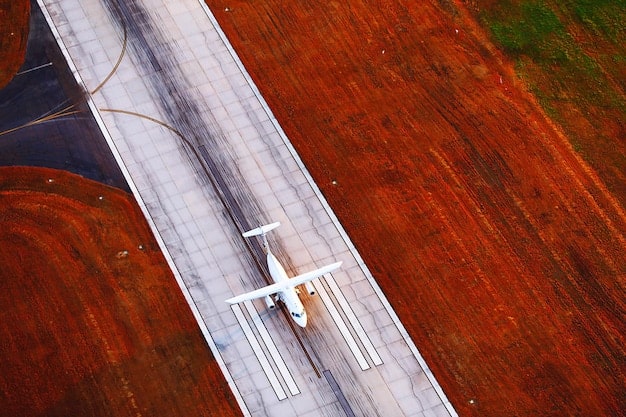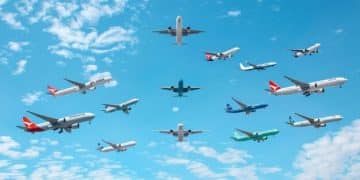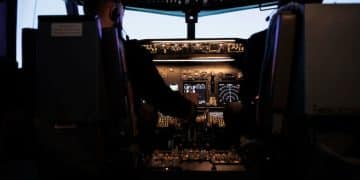Aviation Fuel Prices Surge: Strategies Airlines Use to Cope

Aviation fuel prices are rising, prompting airlines to implement strategies such as fuel hedging, fleet modernization, and surcharges to mitigate increased costs and maintain profitability.
The **aviation fuel prices surge** has become a significant concern for airlines worldwide. Fuel is one of the largest operating expenses for airlines, and sudden increases can impact profitability and potentially lead to increased ticket prices for consumers. This article explores how airlines are responding to these increased costs, examining strategies they are employing to navigate this challenging environment.
Aviation Fuel Price Volatility: An Overview
Aviation fuel, primarily jet fuel, is subject to price fluctuations determined by factors such as crude oil costs, geopolitical events, and refining capacities. Recent trends show that prices have been on the rise, creating significant challenges for airlines globally. This section explores the backdrop of this challenging situation.
Factors Influencing Aviation Fuel Prices
Several factors contribute to the instability in fuel prices. Primarily, being oil prices, geopolitical tensions, and supply chain disruptions. These factors will raise the uncertainty on the fuel prices.
Impact on Airline Operations
Rising fuel costs can significantly affect airline operations, particularly in profitability, route planning, and pricing strategies. Airlines must find innovative ways to mitigate these costs to remain competitive.

- Fuel efficiency improvements.
- Hedging strategies implementation.
- Adjustments in route networks.
The fluctuation in aviation fuel prices poses a fundamental challenge to the aviation industry, requiring airlines to employ various strategies to manage costs and operational efficiency.
Fuel Hedging Strategies: A Safety Net
Fuel hedging is a common financial strategy employed by airlines to mitigate the risk associated with fluctuating fuel prices. By locking in prices in advance, airlines can stabilize their operating costs and protect themselves from sudden price increases.
How Fuel Hedging Works
Fuel hedging involves entering into contracts that fix the price of fuel for a specified period. These contracts can take various forms, including options and swaps, allowing airlines to secure future fuel supplies at predetermined rates.
Successful Hedging Examples
Several airlines have successfully used fuel hedging to navigate periods of price volatility. These examples demonstrate the benefits and potential drawbacks of hedging strategies. It’s not a crystal ball, but rather a tool to mitigate risk.
- Southwest Airlines often uses hedging efficiently.
- Emirates implements hedging for long-term financial stability.
- Ryanair uses hedging to lower costs to customers.
Fuel hedging provides airlines with a degree of protection against price surges, but it is not without risks and requires careful management to ensure its effectiveness.
Fleet Modernization: Investing in Efficiency
Older aircraft tend to be less fuel-efficient than newer models, consuming more fuel per passenger mile. By investing in fleet modernization programs, airlines can reduce their fuel consumption and lower operating costs.

Benefits of New-Generation Aircraft
New-generation aircraft incorporate advanced technologies such as improved engine designs, lightweight materials, and aerodynamic enhancements, resulting in significant fuel savings. In the long run costs are significantly reduced.
Long-Term Cost Savings
While the initial investment in new aircraft can be substantial, the long-term cost savings associated with reduced fuel consumption, lower maintenance costs, and increased reliability make it a worthwhile endeavor for airlines.
Investing in newer, more fuel-efficient aircraft is a key strategy for airlines looking to reduce their fuel costs and improve their operational efficiency.
Operational Efficiency Measures: Optimizing Flight Operations
Beyond fleet modernization, airlines are also implementing various operational efficiency measures to reduce fuel consumption. These measures range from optimizing flight routes to reducing aircraft weight and improving ground operations.
Route Optimization
Advancedroute planning software allows airlines to identify the most fuel-efficient routes, taking into account factors such as wind conditions, altitude, and air traffic congestion. This will make more efficient and money saving routes.
Weight Reduction Strategies
Reducing aircraft weight can have a significant impact on fuel consumption. Airlines are exploring various weight reduction strategies, such as using lighter materials for cabin interiors, optimizing cargo loads, and reducing the amount of potable water carried on board.
- Single-engine taxiing during ground operations.
- Continuous Descent Approaches (CDA).
- Optimized flight altitudes.
By implementing these measures, airlines can minimize fuel consumption and reduce their carbon footprint, while staying competitive in today’s market.
Passing Costs to Consumers: Ticket Surcharges
In some cases, airlines may choose to pass on increased fuel costs to consumers in the form of ticket surcharges. This allows airlines to offset their expenses without significantly impacting their profitability.
The Impact of Fuel Surcharges
Fuel surcharges can increase the overall cost of air travel, potentially deterring some passengers from flying. Airlines must carefully consider the impact of surcharges on demand and competitiveness.
Balancing Profitability and Customer Satisfaction
Airlines must strike a balance between maintaining profitability and ensuring customer satisfaction when implementing fuel surcharges. Transparent communication and fair pricing policies are essential to mitigate any negative impact on customer loyalty.
While ticket surcharges can provide short-term relief, airlines must consider the potential impact on customer demand and brand perception when implementing such measures.
Collaboration and Innovation: The Future of Aviation Fuel
Looking ahead, collaboration and innovation will play a crucial role in shaping the future of aviation fuel. Airlines, manufacturers, and research institutions are working together to develop sustainable aviation fuels and explore alternative propulsion technologies.
Sustainable Aviation Fuels (SAF)
Sustainable aviation fuels (SAF) offer a promising alternative to traditional jet fuel, with the potential to significantly reduce carbon emissions. These fuels can be produced from a variety of renewable sources, including algae, biomass, and waste gases.
Alternative Propulsion Technologies
In addition to SAF, researchers are exploring alternative propulsion technologies such as electric and hybrid-electric aircraft. These technologies could revolutionize the aviation industry, offering the potential for zero-emission flights.
The aviation industry is committed to finding innovative solutions to reduce its environmental impact and ensure a sustainable future for air travel through collaboration and technology.
| Key Point | Brief Description |
|---|---|
| ⛽ Fuel Hedging | Airlines use contracts to lock in fuel prices and reduce price volatility risks. |
| ✈️ Fleet Modernization | Newer aircraft models reduce fuel consumption and maintenance costs. |
| 🌍 Route Optimization | Implementing software to plan the most fuel-efficient routes. |
| 🌱 Sustainable Aviation Fuels | SAF offers a way to reduce carbon emissions. |
FAQ
▼
Fuel hedging is a financial strategy used by airlines to mitigate the risk of fluctuating fuel prices. It involves entering contracts to fix the price of fuel for a specific period, helping airlines stabilize operating costs.
▼
Fleet modernization involves investing in newer, more fuel-efficient aircraft. Modern aircraft use advanced technologies and materials that significantly reduce fuel consumption compared to older models, saving costs.
▼
Operational efficiency measures include route optimization, weight reduction strategies, and improvements to ground operations. These steps minimize fuel use and carbon footprints.
▼
Yes, SAF is a promising alternative made from renewable sources, like algae, which lowers carbon emissions. SAF is viewed as a great source for the future of cleaner airlines.
▼
Airlines add fuel surcharges to tickets to offset increased fuel costs. This helps airlines maintain profitability without drastically affecting their base ticket prices, though it can affect customer demand.
Conclusion
In conclusion, the **aviation fuel prices surge** presents significant challenges for airlines, but through a combination of hedging strategies, fleet modernization, operational efficiencies, and innovative solutions like sustainable fuels, the industry can adapt and ensure a sustainable future for air travel.





